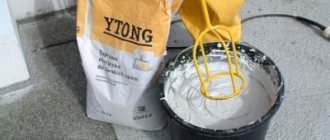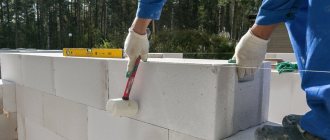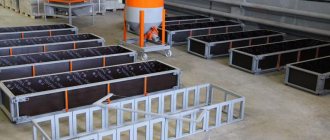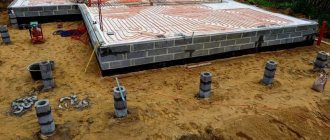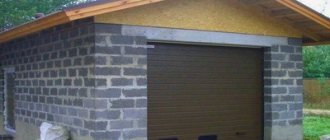Macroflex cement foam is designed for bonding various surfaces. The material, developed using polyurethane, makes it possible to fasten building and finishing materials to each other, eliminate gaps in seams, and its use makes it possible to increase the heat and sound insulation of main structures. The peculiarities of the chemical composition of cement foam make it possible to work at temperatures in the range of 5-35°C.
The main purpose of Makroflex foam cement is to replace the usual cement-sand mortar used in the construction of internal partitions and other non-load-bearing walls made of gas silicate blocks and lightweight concrete products. Refusal of dusty (during preparation) and heavy mortar can significantly increase the speed of construction of structures, and the technical characteristics of foam cement in cylinders are not much inferior to traditional building mixtures.
It is believed that a standard aerosol can of liquid material with a volume of 850 ml can replace a 25 kg bag of M400 cement. At the same time, the craftsman will not have to waste time and energy on preparing the solution and transporting it to the construction site, which significantly reduces labor costs during construction and finishing work.
Characteristics
For specific construction and finishing works, various types of Macroflex foam cement are used. The scope of application depends on the temperature and humidity conditions at the site and the characteristics of the materials that need to be connected.
The general technical characteristics of all products include the following properties:
- density – 20 kg/m3;
- the time required for the formation of surface tension is 5-9 minutes;
- the time required to obtain the calculated strength values is from 25 to 30 minutes;
- water absorption during the day - within 1%, maximum value - no more than 10% during the month;
- sound protection – within 60 dB;
- thermal protection – up to 0.4 W/mhK;
- fluctuations in foam volume – up to 5%.
This material, after gaining strength, is able to maintain design properties at outdoor temperatures from -40°C to +90°C. Short-term temperature surges up to over 100°C are acceptable.
The description of this material states that propellants containing fluorine and chlorine compounds are not used in the solution. Fresh foam emits a slight odor, and when the mounting mixture dries, the odor disappears completely.
How to choose polyurethane foam
Not every mounting foam is suitable for filling and sealing small gaps. Materials with different compositions have different degrees of primary and secondary expansion. When the coefficient of increase in volume is significant, it will not be possible to seal small cracks. Strong pressure during expansion can damage various elements. Therefore, you need to look at this indicator.
It will be possible to seal cracks with polyurethane foam if it is able to penetrate into the smallest pores without causing secondary expansion. In this case, it serves as a sealant.
Typically, polyurethane foam is used to seal cracks in walls. For small amounts of work, you should choose a household product that does not require a construction gun. Included with the foam is a special applicator, a plastic tube, thanks to which the sealing occurs. This mixture is intended for one-time use; an open container can be stored for a day.
So, the main criteria for choosing polyurethane foam for sealing small cracks:
- Low secondary expansion coefficient.
- Small bottle to save money.
- Availability of a special tube included.
- Compliance with requirements for individual jobs.
Regarding the last point, you should select a product that suits the working conditions. The packaging indicates at what temperature it can be worked with, how polymerization occurs, the maximum size of the cavity to be filled and other information.
Kinds
The manufacturer produces several versions of Macroflex foam cement. The use of a specific material depends on the tasks to be solved. The main types of this brand include the following products:
- Makroflex Shaketec - the technical characteristics of this product allow it to be used at any time of the year.
- Makroflex Winter – is distinguished by its ability to maintain installation characteristics at subzero temperatures. This foam is designed to work in the cold season. It provides increased sound insulation of structures and is most often used for installing window and door units.
- Makroflex Premium - doubles the volume; each cylinder is equipped with a special device for spraying foam.
- Makroflex Premium Mega - makes it possible to accurately calculate the dose of material applied and allows for the installation of building foam blocks at sub-zero temperatures in winter conditions. Provides a strong connection of materials down to -15°C.
- Makroflex Pro is a professional version of foam cement. Application – on construction sites for fastening solid materials in critical structures. Possesses powerful adhesion to various substrates.
- Makroflex Whiteteq - differs from other types of aerosol products for bonding surfaces by increased resistance to ultraviolet radiation, while maintaining strength properties. Inside each can there is a metal ball, which allows you to thoroughly mix the solution before use.
Each of the listed types of foam cement allows workers to be relieved of the hard work of preparing cement-sand mortar. The use of a specific type makes it possible to carry out installation work in any conditions and with any material with consistently high quality.
New adhesives in polyurethane-based cylinders
Manufacturers are ranked in order of popularity (based on reviews).
Foam adhesive for Ceresit CT 115 blocks Ceresit CT 115 (Ceresit SM 115), brand Germany, distributors in Russia, volume 0.85 ml, price 400 rub/piece
Material prepared for the website www.moydomik.net
Adhesive foam for blocks H+H LimFixН+Н LimFix, manufacturer Russia, volume 0.75 ml, price 300 rub/piece
Adhesive foam for aerated concrete TYTAN ProfessionalTYTAN Professional (TVM glue Titan) “Adhesive for masonry of aerated concrete and ceramic blocks”, (Selena), cylinder volume 0.75 ml. Adhesive foam Bonolit "Formula Heat"Bonolit Tytan (Bonolit "Formula Heat"), produced in Staraya Kupavna, volume 0.85 ml, price 380 rubles/balloon
Adhesive foam Makroflex Makroflex (Macroflex Foam-cement construction), manufacturer Estonia, volume 0.85 ml, price 300 rub/piece
Laying foam concrete canopies on adhesive foam - video
Scope of application
Macroflex foam cement is convenient for use in construction and finishing work, but it is not used for the construction of capital and load-bearing walls. Critical structures are best erected using traditional mortars. The new material is recommended for the following work:
- for installation of internal partitions;
- for repairing masonry made of aerated concrete, brick or foam concrete;
- for insulation of external walls using heat-insulating mats;
- to carry out repairs of building structures;
- to eliminate gaps in filling seams and joints of panels and other structures;
- for installation of window and door blocks, window sill boards and steps on interfloor stairs in private houses;
- for waterproofing joints in concrete structures.
One aerosol can of this material is enough to install cladding panels on an area of up to 12 sq.m., the same consumption is provided for the construction of a brick wall with a thickness of 250 mm per 10 sq.m.
Aerated concrete blocks - material features
Bonolit aerated blocks contain gypsum, quartz sand, lime and cement. When making aerated concrete slabs, the powdered composition is mixed with water and poured into a mold, where aluminum powder is added as a gas generator. The resulting foam mass is first cut into equal blocks, and then undergoes heat treatment in autoclaves. As a result of gas formation, the blocks are porous, and they retain air that can retain heat.
Another advantage of this building material is its light weight. Cut with a string, the gas blocks have exactly the same size, making the masonry neat. Gypsum and lime give this building material a white color.
Aerated concrete foam blocks are not suitable for the construction of multi-story high-rise buildings - the load on the lower floors will be too great, but for the construction of two-three-story houses, interior partitions, warehouses or auxiliary premises, this material is used quite successfully.
Advantages and disadvantages
Before starting construction work using a new material, it is necessary to find out what advantages and disadvantages of cement foam can affect the quality of work.
The positive points include:
- ease of storage, carrying and use;
- cost comparable to the price of conventional materials;
- the ability of the material to bond surfaces with different characteristics;
- instant setting of the material;
- ability to work at low and high temperatures;
- the use of foam cement does not involve a lot of waste and dust, which reduces the time for cleaning the room;
- foam cement is an effective means of sound and heat insulation;
- the durability of the material allows it to be used for most critical structures.
The disadvantages of foam cement include the following:
- this material has weak resistance to UV rays - when they hit the foam cement, a loss of strength characteristics and gradual destruction occur;
- When working with foam, it is necessary to use personal protective equipment for the respiratory tract and visual organs.
Efficiency comparison.
Disadvantages of Foam Blocks
- There is no proof of the test of time.
- It cannot be used for laying load-bearing walls (although some manufacturers already claim this possibility).
- High requirements for block geometry (no more than 3 mm per 1 meter of masonry).
- High price (evened out by low consumption).
Is it possible to lay an aerated block on foam?
Manufacturers recommend laying blocks on foam for internal self-supporting walls (foam concrete, aerated concrete, gas silicate). According to reviews, many even install load-bearing walls, but not more than one or two floors.
Dismantling a block glued with foam The main doubt regarding polyurethane adhesive in the form of foam lies in the ability of polyurethane foam adhesive to withstand vertical loads.
Although, blocks glued together with foam are almost impossible to break, and if they can be broken, it is not along the seam, but along the structure of the block.
Tips for use
When carrying out installation work using Macroflex foam cement, the following tips should be taken into account:
- for better adhesion, it is necessary to remove dust and small fractions from the working surface;
- if necessary, degrease the surface;
- before starting work in the cold season, it is recommended to keep the cylinders in a warm room for at least half a day;
- periodically the aerosol can with the material must be shaken vigorously;
- for the installation of structural elements, a step between the foam-cement strips of 15 cm is used, the distance from the edge of the element must be at least 5 cm;
- to obtain an even strip of foam of equal thickness, it is recommended to use a mounting gun;
- The gun is cleaned from material residues using a special composition;
- for better adhesion of the foam to the surface of the structural element, after cleaning it from dust it is recommended to moisten it;
- Seams and joints are sealed from the bottom up.
Foam cement Macroflex
Polyurethane foam cement is a universal product , the characteristics of which allow it to be used in many construction, repair and reconstruction works. At the moment (end of 2022) it is possible to find foam cement only under the Makroflex brand . The company of the same name is known as a manufacturer of a wide range of one-component polyurethane foams. But the assortment also includes assembly adhesives, sealants, and accessories.
Description
Makroflex polyurethane foam cement is a ready-to-use one-component composition that hardens when exposed to moisture. It is an effective tool for the rapid construction of partitions and walls from building foam and aerated concrete and ceramic blocks, significantly increasing labor productivity. This innovative product is designed to replace heavy bags of cement and large equipment or a whole list of tools and devices for preparing concrete solutions, will save energy, protect the performer from the harmful effects of dust and dirt, and eliminate time-consuming work.
Foam cement allows work to be completed with less effort and helps cut the time spent in half . It does not require the use of special tools or preparatory work, which significantly reduces the waste of working time. The composition is distinguished by high adhesion to substrates and is suitable for indoor and outdoor use. Foam cement is in many ways similar to conventional polyurethane foam. For example, both building materials are produced in aerosol cans, which ensures ease and efficiency of work. To apply foam cement, a special gun is required that is attached to a cylinder. After leaving the cylinder, the cement is a gray foamy mass . After leaving the container, the material has a slight smell of polyurethane; after setting and hardening, the smell disappears. The presence of foam in water leads to the absorption of moisture, which negatively affects further strength.
Specifications
- one cylinder is replaced by 25 kg. cement or glue;
- productivity reaches 10-12 sq.m. brickwork;
- possibility of use at ambient temperatures from -5 to +35 degrees Celsius;
- 100% thermal insulation, no cold bridges;
- obtaining especially strong seams, which ensures high adhesion strength;
- possibility of use at low temperatures and high humidity;
- it is possible to begin the next stage of work within 2 hours after applying the foam cement;
- possibility of indoor and outdoor use;
- density - about 20 kg/cub.m.;
- time until film forms - 5-9 minutes;
- time until pruning is possible - 20-30 minutes;
- hardening pressure < 10 kPa;
- expansion after hardening - 40%;
- holding time - 25 minutes;
- dimensional stability - +/- 5%;
- for filling joints with a width of 0.5 to 50 mm;
- shear strength is about 50 kPa;
- fire hazard class - F;
- water absorption for 24 hours and 28 days is no more than 1 and 10%, respectively;
- sound absorption - 60 dB;
- temperature resistance of the hardened material - from -40 to +90 degrees;
- thermal conductivity of the hardened material - 0.037 ... 0.40 W/mK;
- no fire resistance;
- high adhesion to mineral substrates;
- high adhesion with most building materials , maximum tensile strength with different materials differs: with inorganic building materials: concrete - 0.3;
- foam concrete - 0.15;
- drywall - 0.10;
- ceramic blocks - 0.30;
- glass - 0.30;
- galvanized metal sheet - 0.10;
- bitumen coating - 0.25 MPa;
The main difference between cement foam and polyurethane foam is the possibility of using the first material as polyurethane foam adhesive. There are also differences between foam cement and other fastening compounds. Cement foam shrinks slightly, which is especially important for obtaining durable masonry. The ability to form thin seams, through which heat loss is significantly less. Cement in cylinders is sold at a higher price, but is also consumed more economically. Possibility to carry out work in the cold and indoors, because does not have a sharp or strong odor.
Advantages and disadvantages
The manufacturer notes the following advantages:
- economical consumption, 1 cylinder is enough for 10-12 sq.m. masonry;
- high thermal insulation properties;
- rapid hardening, after 2 hours it is possible to proceed to the next stage of work;
- resistance to mold and mildew;
- compliance with one of the international requirements for construction aerosols - the absence of propellants in the composition;
- Maximum foam strength can be achieved when working with dry and wet substrates, but there should be no snow or ice on the surface, because
- after thawing, the foam and the treated base will become separate elements from each other.
In addition, it is possible to note other advantages:
- the product is ready for use;
- packaging convenient for transportation and use;
- versatility of the material, the ability to be used in many construction works;
- fairly low cost, availability;
- rapid hardening, which saves time and does not extend the work process;
- combination with many building materials;
- weather resistance;
- absence of dust and dirt during the work process;
- providing additional protection from cold and noise;
- effective and reliable adhesion to various types of surfaces;
- It is possible to carry out work in conditions of lack of electricity and water.
But there are also some disadvantages:
- exposure to direct sunlight leads to the gradual destruction of the hardened material, so protection from UV radiation is required using paint, sealant, plaster, mortar or another type of coating;
- requires the use of both a respirator and goggles during use;
- increased requirements for the geometry of masonry elements.
Reviews
The reviews are generally positive , the performers note the ease of use, the high quality and strength of the resulting seams, reliable fixation of masonry elements, cost-effectiveness, high foam yield, and efficiency of work. Customers satisfied with the product only note the high cost of the foam . But there are also negative opinions. Consumers note failure to fulfill the functions specified by the manufacturer, receiving an unreliable and fragile monolith, which can be explained by the purchase of low-quality, counterfeit building material.
Application
Foam cement is used for the construction of partition walls from various types of building blocks: foam and aerated concrete, ceramic, etc. It is important to remember that the composition is not intended for arranging load-bearing walls. In addition, the composition cannot be used for laying blocks with size deviations greater than 1 mm. and/or irregularly shaped, for working with building blocks with voids in accordance with patent EP 1 623 078 B1. In addition, the composition is used:
- fastening thermal insulation boards to the wall, floor and ceiling;
- bricklaying;
- repair of damaged walls;
- fastening decorative panels to internal and external walls, floors and ceilings;
- installation of window frames, window sills, stairs;
- sealing voids, gaps, seams, cracks.
Thus, foam cement can be used both as mounting foam and as cement masonry mortar.
Recommendations for use
The manufacturer provides recommendations on the use of the composition and the performance of work. First of all, it is necessary to prepare the surface . It is necessary to clean the base from any contaminants : dirt, dust, bitumen, lubricants, make sure there are no foreign particles. Building blocks should be dry , and other surfaces may be damp, but there should be no frost or ice . Residues of paint and other coatings with low adhesive properties must be completely removed. To obtain a high-quality result, you also need to follow several recommendations and tips .
- Work should be performed at ambient temperatures from -5 to +35 degrees Celsius.
- It is recommended to keep the foam container at room temperature for at least 12 hours.
- Before use, the container must be shaken vigorously 15-20 times.
- Then you need to remove the protective cover and screw the gun to the cylinder, while keeping the cylinder bottom down.
- But in the process of applying foam, you need to hold the container upside down.
- The speed of release of the composition from the cylinder is regulated by pressing the trigger and the screw of the gun.
- During the application of foam, it is necessary to shake the container periodically.
- It is not recommended to remove the gun from the cylinder until it is fully used.
- To replace a cylinder, you need to disconnect the empty container from the gun and replace it with a new one in such a way as to prevent air from entering the gun.
- Upon completion of the work, you need to remove the gun from the cylinder, clean the “weapon” using a special cleaning liquid; it is recommended to use a product from the Macroflex brand. The hardened composition can only be removed mechanically.
Foam cement Macroflex. Photo by Leroy Merlin
The process of applying foam cement is as follows:
- Foam cement is applied in parallel strips to the contact vertical and horizontal edges of blocks or bricks. If the block thickness is less than 11.5 cm, 1 strip is applied; more than 11.5 cm - apply an additional strip. The distance from the application line to the edge should be 3-5 cm.
Attention! The first row of masonry can be bound with foam cement only if the surface of the base is smooth and horizontal. Otherwise, it is necessary to lay the 1st row on a base leveled using mortar.
- The installation of the blocks must be done within 3 minutes after applying the foam cement, and they must be lightly tapped to level and stabilize the bonding layer.
- It is necessary to check the horizontalness of each row using a level. If a deviation is detected, the surface should be sanded with an abrasive material until it is perfectly level.
- The next stage (plastering) can be completed no less than 2 hours after gluing.
Foam cement is recommended to be used within 15 months . It is recommended to store the composition at temperatures from +5 to +25 degrees, which will extend the shelf life. It is recommended to store the cylinder with the valve facing up . Spontaneous fall of the cylinder should be avoided. When transporting in a car, cylinders must be wrapped in cloth and placed in the trunk ; transportation in the passenger compartment is not allowed. The cylinder should be kept away from sharp objects , because the container is under pressure. The consumption of the composition depends on climatic conditions, the porosity of the material, and the experience of the performer. In practice, the consumption indicated on the packaging is never equal to the actual values. Therefore, it is necessary to perform a calculation and purchase adhesive-cement with a reserve . To calculate the volume of foam for a seam, you need to multiply the length of the seam by the width and depth.
Preparation and embedding algorithm
Before embedding, preliminary preparation is carried out, which consists of the following:
- Cleaning surfaces from dirt, dust, old sealant. This may require special tools and tools. You cannot apply polyurethane foam to an existing composition. You also need to degrease the surface and dry it.
2. Prepare the balloon itself, bringing it to room temperature, a knife, tape or tape.
3. Shake the bottle to mix all components, remove the cap, and insert the dispenser.
4. Wear safety glasses, a mask, and long sleeves.
5. Apply sealant, holding the can upside down.
6. You can cut off the residual material with a knife after complete hardening - after 24 hours.
